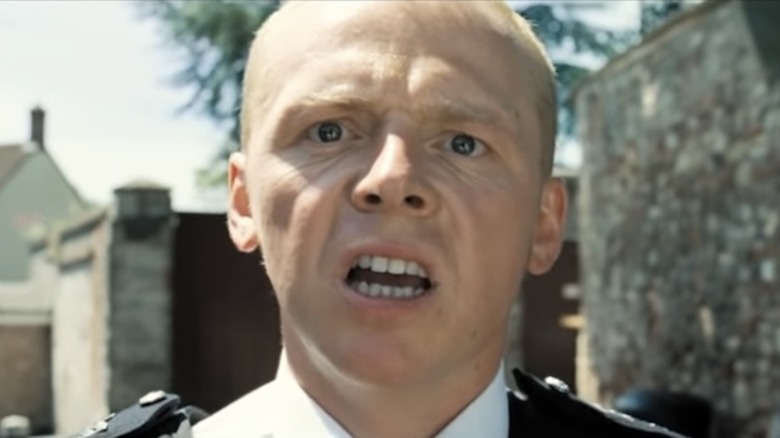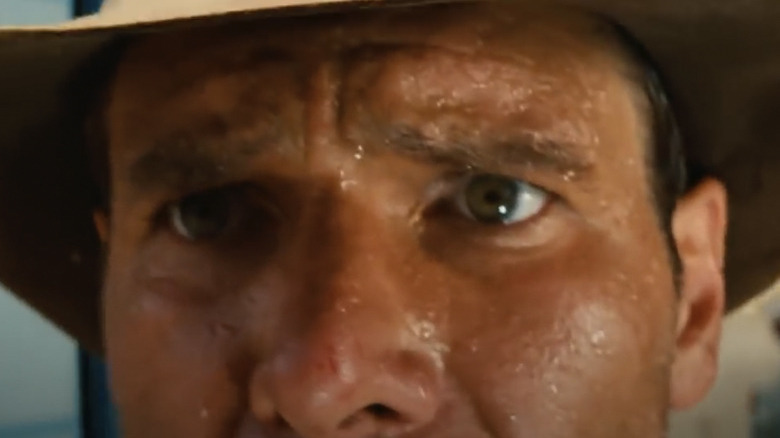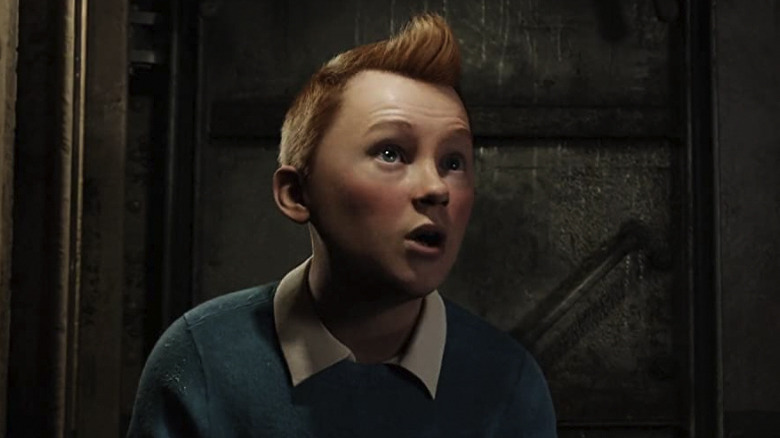Hot Fuzz Features A Shot Ripped Straight From Indiana Jones
Simon Pegg may play British cop Nicholas Angel's courageous stunts for laughs, but his scenes of derring-do in "Hot Fuzz" are imitations of another cinematic hero.
Edgar Wright, who also directed Pegg in "Shaun of the Dead," wanted to give Angel a whiff of one of his favorite adventurers, Indiana Jones. In a blink-and-you'll-miss-it moment, the director nods to the 1981 masterpiece "Raiders of the Lost Ark." Look closely at the frantic chase scene after a shoplifter in "Hot Fuzz" and you'll spot a close-up shot of Pegg that mimics the same framing of Jones when he runs after the bad guys carrying Marion Ravenwood through a Cairo market (via Vanity Fair).
The "Raiders" reference takes place on an idyllic street in the cathedral city of Wells, Somerset, Wright's hometown. Though Wright never intended to direct his third feature film there, the Somerset village ended up being the perfect location for his buddy cop comedy. When Pegg rounds the corner for that close-up, he's just around the block from Wright's old school. As Wright explained:
"So there's the film that couldn't be more close to home for me. It's very sort of funny to watch and then make like a big American-style action film in my hometown."
With Steven Spielberg, Wright seems to have found a kindred spirit in the movie business. Like the "Raiders" director, Wright also got his start in TV, and his cult comedy "Spaced" helped establish his visual style. In a Wright comedy, characters slide into view or pop up in unexpected places. The position of Wright's actors can emphasize the punchline in the written dialogue or serve as a sight gag on their own.
That directing echoes Spielberg's early TV work in "Columbo," where painstaking blocking between detective and suspect ratchets up the tension written in the script. As observed by Forward, the director used the TV series to experiment with camerawork that would become his trademark style in future feature films. That included the so-called "Spielberg face," a closeup shot of a character with mouth agape and eyes widened. Audiences might find a topsy-turvy parallel to the "Spielberg face" in Wright's comedies as well. Where Spielberg's quintessential shot signifies awe or horror, Wright's variation on the slack-jawed expression is more often a joke about the disillusioned Gen Xers at the center of his films.
Dueling directors
Both directors are perfectionists when it comes to blocking, using the precise framing of characters to deliver a laugh or a jump scare. As Tony Zhou points out, Spielberg's framing of Chief Martin Brody chumming the waters in "Jaws" gives the audience its first full-frontal look at the face of the terrifying shark. When Spielberg closes in on Indiana's face in "Raiders," the shot is meant to convey anxiety as he searches for Marion. In "Hot Fuzz," Wright uses that same framing as a comedic tool rather than a suspenseful one.
It's no wonder, then, that Wright can sound more like an earnest fanboy than a Hollywood peer, as he did when he praised Spielberg's 2018 action film, "Ready Player One" on Twitter. Wright singled out Spielberg's blocking in the film, a technique that Wright mastered himself in the carefully choreographed car chase scenes in his 2017 heist film, "Baby Driver."
Still processing the audio visual feast that is Spielberg’s ‘Ready Player One’. It has several scenes that confirm again him as the master of blocking action set pieces (big and small). And given this must have been a gargantuan VFX challenge it could really be called ‘The Post’.
— edgarwright (@edgarwright) March 20, 2018
From his comedies to his thrillers, Wright has imbued his work with Spielbergian flair. During the making of "Baby Driver," two movies loomed in Wright's brain. The first was Walter Hill's "The Driver," starring Frank Bruno as "The Kid," a clear influence on the eponymous character in "Baby Driver." The other was "Duel," an early made-for-TV-movie by Spielberg that followed an everyday salesman stalked by a manic, almost supernatural truck (via Empire). The network gave Spielberg just 11 days to shoot the 74-minute movie, so pulling off "Duel" required meticulous planning. To get the shots he needed, the young director used five cameras — including one he mounted inside the car and on the truck.
That thriller's antagonist, a devilish truck driven by an unseen driver, is viewed by many as Spielberg's dress rehearsal for "Jaws," whose villain also remains hidden for much of the film. In the intro for his Empire interview with Spielberg, Wright writes about his first impressions of "Duel" and where it stands in the venerated director's canon.
"I saw 'Duel' on TV as a kid and marvelled, even then, at it. It is a pure engine for suspense, a brilliant exercise in near-silent cinema. I still think, even in the wake of his later classics, it's still one of the greatest displays of Spielberg's talent and a masterclass for young filmmakers."
The student becomes the co-worker
In a full-circle career move, Wright would go on to collaborate with his idol on an animated feature that led some critics to draw "Indiana Jones" parallels. Wright co-wrote the screenplay for Spielberg's 2011 movie "The Adventures of Tintin," a motion-captured adaptation of Belgian cartoonist Hergé's classic comic about a young reporter and his dog, Snowy. Some critics even endorsed "Tintin" as a better heir to "Raiders of the Lost Ark" than Spielberg's lackluster sequel, "Indiana Jones and the Kingdom of the Crystal Skull."
Wright's "Raiders" reference in "Hot Fuzz" is a quick nod to the master, a filmmaker he has clearly learned a lot from — and one he can now call a collaborator.


